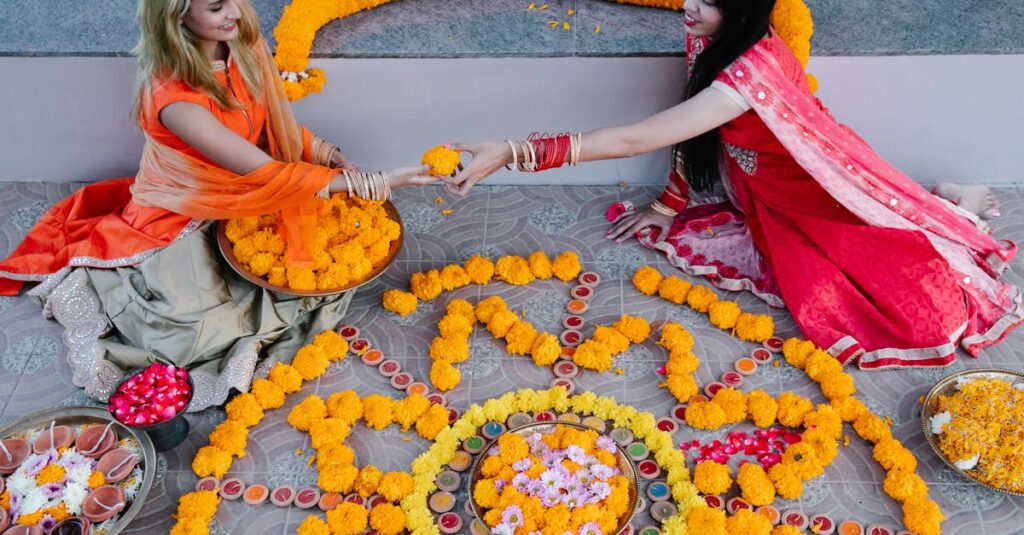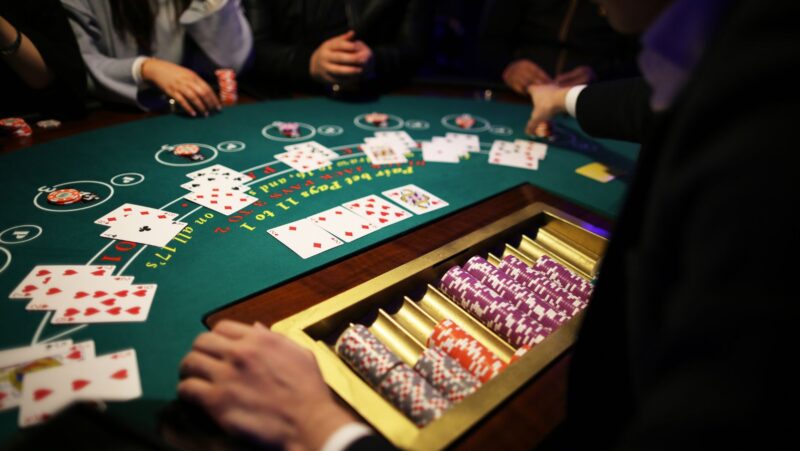
As I delve into the world of Indian art, I’m captivated by the mesmerizing beauty of rangoli. This ancient form of floor decoration is more than just a visual treat; it’s a cultural tradition that brings vibrant colors and intricate patterns to life.
Beautiful:onysg0ildks= rangoli, also known as kolam or muggu, has been an integral part of Indian festivities for centuries. I’ve discovered that these stunning designs aren’t just created for aesthetic appeal – they hold deep symbolism and are believed to bring good luck and prosperity to homes. From simple geometric shapes to elaborate floral motifs, rangoli’s versatility never ceases to amaze me.
Key Takeaways
- Rangoli is a traditional Indian art form featuring intricate floor patterns created with colorful materials, symbolizing good luck and prosperity.
- Traditional rangoli materials include rice flour, colored powders, sand, flower petals, and grains, aligning with eco-friendly practices.
- Basic rangoli patterns often incorporate geometric shapes and common motifs like flowers, peacocks, and mandalas.
- Modern rangoli has evolved to include contemporary styles, 3D designs, and digital creations, while maintaining cultural significance.
- Color choices in rangoli hold deep symbolic meanings, with both natural and synthetic pigments used to create vibrant designs.
Beautiful:Onysg0ildks= Rangoli
Rangoli is a traditional Indian art form involving intricate patterns created on floors using colorful materials. This ancient practice has deep cultural roots and spiritual significance in Indian society.
Origins and Cultural Significance
Beautiful:onysg0ildks= rangoli originated in ancient India as a form of threshold art. It’s believed to have been mentioned in the Chitralakshana, the earliest Indian treatise on painting. Rangoli serves as a welcoming symbol for Hindu deities, particularly Lakshmi, the goddess of wealth and prosperity. During festivals like Diwali and Pongal, families create elaborate rangoli designs to invite blessings and ward off evil spirits. The art form also plays a crucial role in social bonding, with women gathering to create rangoli designs together, fostering community spirit.
Traditional Materials Used
Rangoli artists traditionally use natural, readily available materials to create their designs:
- Rice flour: The most common base material, chosen for its bright white color and smooth texture
- Colored powders: Made from natural sources like turmeric (yellow), vermilion (red), and indigo (blue)
- Sand: Used to create a smooth surface for the design
- Flower petals: Incorporated for added color and texture
- Lentils and grains: Utilized to create intricate patterns and add dimension
These materials not only contribute to the visual appeal of rangoli but also align with the eco-friendly ethos of Indian culture. As the designs are temporary, using biodegradable materials ensures minimal environmental impact.
The Art of Creating Beautiful Rangoli
Creating beautiful rangoli requires skill, patience, and creativity. I’ll explore the fundamental patterns and designs, as well as advanced techniques used to craft stunning rangoli art.
Basic Patterns and Designs
Rangoli patterns often start with simple geometric shapes like circles, squares, and triangles. These basic forms serve as the foundation for more intricate designs. Common motifs include:
- Floral patterns: Stylized lotus flowers, marigolds, and sunflowers
- Peacock designs: Incorporating the national bird of India
- Swastika symbols: Representing good fortune and wellbeing
- Dot patterns: Connecting dots to create symmetrical shapes
- Mandala-inspired designs: Circular patterns with radial symmetry
To create these patterns, I use a freehand technique or stencils for precise outlines. The designs are then filled with vibrant colors, typically starting from the center and working outwards.
Advanced Techniques
For more complex rangoli designs, I employ several advanced techniques:
- Layering: Building depth by overlapping patterns and colors
- Shading: Using different shades of the same color to create dimension
- 3D effects: Incorporating optical illusions to make designs appear three-dimensional
- Mixed media: Combining traditional powders with materials like mirrors, beads, or diyas
- Negative space: Utilizing empty areas to enhance the overall design
These techniques require precision and practice. I often sketch the design beforehand and use grid patterns to maintain symmetry. For intricate details, I use fine-tipped tools or squeeze bottles filled with colored powders.
Rangoli in Modern Times
Rangoli has evolved significantly in recent years, adapting to contemporary aesthetics while maintaining its cultural roots. I’ve observed how this ancient art form has seamlessly blended tradition with innovation, creating new expressions of creativity and cultural pride.
Contemporary Styles and Innovations
Modern rangoli designs incorporate a wide range of materials and techniques, expanding beyond traditional powders and grains. Artists now use acrylic paints, glitter, sequins, and even LED lights to create stunning visual effects. 3D rangoli designs have gained popularity, adding depth and dimension to floor art. Digital rangoli, created using graphic design software, has emerged as a new form of expression, allowing artists to share their creations globally through social media platforms.
Rangoli Competitions and Festivals
Rangoli competitions have become a staple at cultural events and festivals across India and in diaspora communities worldwide. These contests showcase incredible talent and creativity, often featuring themes that blend traditional motifs with contemporary issues like environmental conservation or social justice. Major cities host annual rangoli festivals, attracting thousands of participants and spectators. Corporate events and shopping malls frequently incorporate rangoli displays, bringing this art form into everyday urban spaces and introducing it to new audiences.
The Beauty of Rangoli Colors
Rangoli colors are the heart and soul of this vibrant art form, bringing life to intricate patterns and designs. The careful selection and application of colors transform simple floor decorations into captivating masterpieces that delight the senses and evoke deep cultural meanings.
Symbolism in Color Choices
Color choices in rangoli are far more than aesthetic decisions; they’re deeply rooted in symbolism and tradition. Red symbolizes love, fertility, and auspiciousness, often used in wedding rangolis. Yellow represents turmeric, a sacred element in Hindu rituals, signifying purity and prosperity. Green echoes nature and growth, while blue represents Lord Krishna and the vastness of the sky. White, created using rice flour, symbolizes peace and purity. Orange, associated with Lord Ganesha, signifies strength and courage. The strategic use of these colors in rangoli designs creates a visual language that communicates cultural values and spiritual beliefs.
Natural vs. Synthetic Pigments
Traditional rangoli artists primarily use natural pigments derived from plants, flowers, and minerals. Turmeric produces vibrant yellow, while kumkum (a powder made from turmeric or saffron) creates deep red hues. Dried and powdered leaves yield various shades of green, and indigo plants provide rich blues. These natural pigments align with the eco-friendly ethos of rangoli art. However, synthetic pigments have gained popularity in recent years due to their wider color range and longer-lasting vibrancy. These artificial colors come in powder form or as liquid dyes, offering artists more flexibility in their designs. While synthetic pigments provide a broader palette, many artists still prefer natural colors for their cultural significance and environmental sustainability.
Preserving the Tradition of Rangoli
Preserving the tradition of rangoli is crucial for maintaining India’s rich cultural heritage. This ancient art form continues to evolve while retaining its core values and significance.
Teaching the Art to Future Generations
Teaching rangoli to younger generations ensures its survival and cultural relevance. Many schools in India have incorporated rangoli-making into their curriculum, introducing students to this traditional art form at an early age. Workshops and community events provide hands-on experiences, allowing children to learn basic patterns and techniques. Families play a vital role in passing down rangoli traditions, with elders teaching younger members during festivals and special occasions. Online tutorials and social media platforms have made learning rangoli more accessible, enabling enthusiasts worldwide to explore and practice this art form.
Adapting Rangoli for Different Occasions
Rangoli’s versatility allows for adaptation to various events and celebrations. During weddings, intricate designs often incorporate symbolic elements representing love and union. For religious festivals, rangoli patterns may feature deities or sacred symbols specific to the occasion. Corporate events increasingly use rangoli to add a touch of Indian culture, with designs incorporating company logos or themes. Modern artists create contemporary rangoli designs for art exhibitions, blending traditional techniques with innovative concepts. Seasonal rangoli designs reflect nature’s changing colors, with motifs ranging from spring flowers to autumn leaves. The adaptability of rangoli ensures its relevance in both traditional and modern contexts, preserving its essence while embracing new forms of expression.
Rich Cultural Heritage
Rangoli stands as a vibrant testament to India’s rich cultural heritage. Its evolution from traditional floor art to modern expressions showcases its enduring appeal and adaptability. As we embrace new techniques and materials we’re not just preserving an art form but nurturing a living tradition. Rangoli’s ability to bring people together foster creativity and add beauty to our surroundings makes it truly special. Whether created with traditional powders or digital tools rangoli continues to captivate and inspire reminding us of the power of art to transcend time and cultural boundaries.












